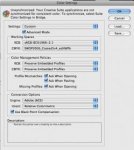Inivin,
I can only tell you how and why I do it here where I work, and you decide if a late-binding workflow or early-binding workflow is for you.
A late-binding workflow is where you keep profiles throughout the workflow and let the rip color manage. In essence, you always want to honor profiles in this workflow, and convert to CMYK or grayscale as late in the workflow as possible. If you are using RGB and don't get a lot of CMYK in, are making the separations yourself, then I'd say this is the recommended method. Rich pointed that method out, and I'm not disagreeing with anything he said about that method.
Rich looks to also be talking about maybe CMYK repurposing, which I thought was a problem at one time until I discovered what I'll tell you next. Since I discovered what I'll tell you next, I don't really have any problems (and didn't really have problems before that, I just thought that they might be problems, but have always used the defaults, so never really had problems in reality).
Late-binding workflow is great if you do separations, but what do you do if you get already-separated CMYK? What CMYK is it?
An early-binding workflow is what I still use. It's an older-type workflow that existed before late-binding became available. You see, I get a lot of already-converted-to-CMYK images. And my customers build in CMYK. And I've noticed over the years that they usually don't change the default color settings. So I get sRGB IEC 61966-21 RGB images if I get images. I also get this RGB when I work with Microsoft products (I don't have the latest Microsoft OS or products where they've added color management, so color was always assumed to be sRGB on all their products which all of them work in RGB color). I get SWOP images.
The interesting thing about SWOP images I get are that they are converted to SWOP using Relative Colorimetric Intent. And (getting more technical here), if I plot the NPDC (e.g. G7 method, see IDEAlliance.org) of UNPRINTED SWOP (because of using Relative Colorimetric Intent) and compare it with the PRINTED GRACoL2006_Coated1v2 (official profile for coated paper), the two NPDC's almost match exactly. What does this tell me? Well, I confirmed with proofs, but what this tells me is that I'm fine printing SWOP images on GRACoL (and also G7 uncoated beta really) with no problem. In fact, what I tested and found goes along with what was said in the initial G7 How-To PDF. We can get a "natural" appearance printing SWOP separations on GRACoL. I do it every day no problem.
So it can be as easy as (first 2 steps are already done for you because they are the defaults in Adobe apps if using North American General Purpose 2, which I think is still the default color settings file):
1. Set RGB profile in all apps to sRGB IEC61966-2.1.
2. Set CMYK profile in all apps to U.S. Web Coated (SWOP) v2.
3. Make sure you honor embedded RGB profiles (to use if customer actually embedded one) and turn CMYK color management policies to Off (to make sure you're not changing customer's CMYK).
4. Set up proofing to use official profiles (if available) as source profiles (what you want to match), and custom proofer profiles as target.
5. Set up press / paper / plate curves combo using G7 (IDEAlink Curve 2, and you probably want to get a G7 Expert).
6. Sit back and enjoy color problems disappear. Let Adobe do all the conversions for you, just by using their default profiles (I only change CMYK color management policy because I want to MAKE SURE my CMYK is not getting changed).
Regards,
Don
I'm trying to totally understand how profiles function and how our customers should use them.
Workflow - Photoshop --> InDesign --> Prinergy
The profile is attached to the Photoshop file, which is placed in InDesign. InDesign has a different setup for Color Settings. This is output to a PDF and Refined through Prinergy - which has a third profile.
- Does InDesign replace the Photoshop profile?
- If the Color Setting in InDesign is set to CMM off, then our customer is not viewing the file as it will print - correct? But it requires that setting to keep InDesign from overriding any profiles.
Prinergy is setup to strip all profiles, but the conversion seems to be taking place when the PDF is created.
If all the above is true, how can the customer view color in InDesign and be assured the final print file will match?













